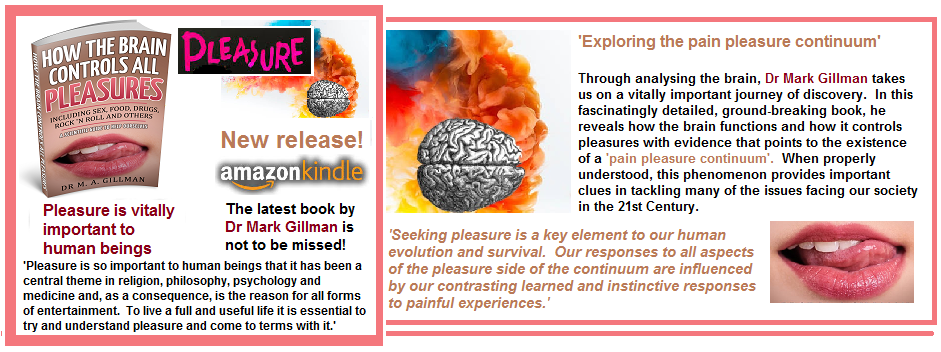Click here to get your copy of the latest book by Dr Mark Gillman!
https://www.amazon.com/dp/B07B21J7JW
romantic love, sex and attachment as physiological addictions
Clearly, romantic love, sex and attachment have addictive properties since they are repetitive behaviours that form part of our survival mechanism. Similar to other survival processes, their ability to produce pleasure is likely to be their most addictive quality; a factor that accords well with the notion of a pain-pleasure continuum. Therefore, it follows that under certain circumstances romantic love, sex and attachment may lead to compulsive and excessive behaviour, which is expressed as a form of pathological addiction.
Sex as an addiction
The pleasure generating brain areas, including the nucleus accumbens, amygdala, prefrontal and orbitofrontal cortices are all involved in sexual desire, arousal and orgasm. All mammals need sexual activity for the survival of their species. We are no exception. Almost everyone enjoys sex. It is for that very self-same reason that our need for sex is so strong in healthy people, which is not the case with those who are ill, whether they suffer from a physical illness or a psychiatric condition such as depression.
Some even complain that they are addicted and think of indulging constantly. As already discussed, if one views the situation dispassionately, we are all addicted to sex. However, it is the degree to which sex occupies an individual’s mind that is important. If, as in certain cases, it occupies the mind so enduringly that obtaining and indulging have negative consequences, it fulfils the criteria as an addiction.
Even among normal people sex has strong and even compulsive characteristics, which can lead to negative consequences. Ask any boss and/or his secretary who behaved recklessly at a Christmas party. Of course, by the same token, it can have very positive consequences (apart from the pleasure aspect), which include producing the next generation. A once-off irresponsible encounter is clearly something that does not qualify as an addiction, unless it happens repeatedly.
The strength of the sex urge and the pleasure associated with it is undeniable. On the other hand, regular and uncontrolled compulsive indulgence in sex without regard for the consequences, and particularly if these episodes regularly result in negative situations, is a problem. In these cases, most people working in the field would agree that such behaviour qualifies as a sex addiction.
All the same brain regions are involved in drug and alcohol addiction.I t is therefore not surprising that another addiction like sex addiction occurs secondary to a disturbance in these areas. Sexual arousal in women has been positively related to activity in the ventral tegmental area; a region that is also stimulated by cocaine induced euphoria. Also, perhaps not surprisingly, areas specifically related to sexual activity and hormonal control and not necessarily implicated in pleasure, are also involved.
For instance, dopamine neurons in the hypothalamus and neurons that connect to the pituitary (Fig 3), which, together exert control over most of the body’s hormones, are active during sex. For instance, both testosterone and oestrogen influence sexual arousal, while testosterone can prompt obsessive sexual thoughts. Animals will self-administer testosterone and people have been known to abuse it.3 Fisher also refers to amphetamine addicts who mention that when they are on the drug their sexual desire is continuous. And we know that amphetamine, like cocaine, stimulates dopamine neurotransmission.
Obviously, there are close parallels between substance abuse and sexual activity. And the overlap in areas such as the mesolimbic pleasure system, as well as the endogenous opioid involvement in both phenomena, provides strong evidence that addiction to drugs, alcohol and sex have striking similarities.
Romantic love
Helen Fisher refers to the strong evolutionary influences underlying romantic love, and in particular how people and animals choose potential partners. Throughout her book she provides evidence across many disparate members of the animal kingdom that animals are driven to find a preferred mate, and that the quest for such a mate strongly influences their reproductive behaviour.
Fisher also mentions that lovers become obsessed with each other. We all know that even in normal early romantic involvements the partners may be prone to impulsive behaviour. And in extreme cases, we have heard of cases where the obsession can be compulsive and result in actions that produce undesirable consequences for either or both partners. In short, chiefly in the early stages of romance, the partners become addicted to each other to a greater or lesser degree. Fisher also suggests that love is an addiction, and like any other addiction, is mediated by dopamine. Other similarities between romantic love and addiction are craving, obsession, compulsion, tolerance, dependence, withdrawal and relapse.
‘You like to think that you’re immune to the stuff….oh yeah
It’s closer to the truth to say you can’t get enough
You know you’re gonna have to face it
You’re addicted to love.’
Brown and colleagues, using brain imaging in people, showed that incipient romantic love stimulates the ventral tegmental area and dorsal striatum (caudate nucleus and putamen, indicating that it uses the usual brain systems involved in motivation and satisfaction of pleasurable states.

